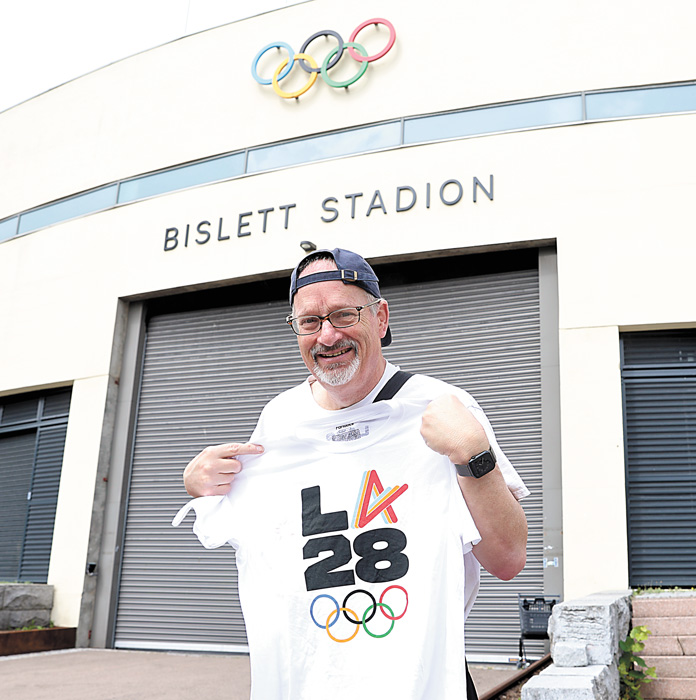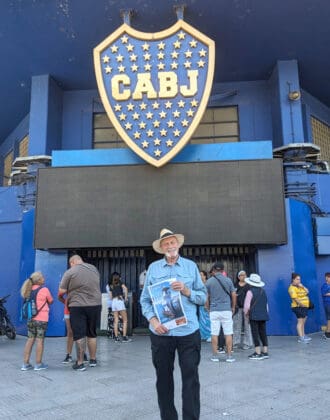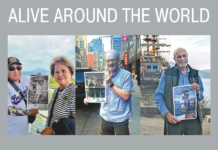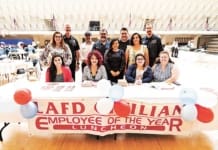 Send in your ALIVE! AROUND THE WORLD
Send in your ALIVE! AROUND THE WORLD
Take Alive! with you wherever you go! Bring your recent copy of Alive! with you when you travel and snap a high resolution photo of you holding Alive!
Send in your pictures and descriptive text using the online form, and we’ll publish it.
SUBMIT YOUR ALIVE! AROUND THE WORLD
![]()
Oslo

In anticipation of the LA Olympics and Paralympics in LA in 2028, Alive! editor John Burnes toured other Olympic stadia. First up: the Bislett Olympic Stadium in Oslo, Norway, site of the 1952 Winter Olympics.
Letter From Argentina, Pt. 3
Tango, Empanadas and Soccer.

La Boca is a picturesque bohemian neighborhood in Buenos Aires. Besides being the birthplace of tango, its colorful buildings around Caminito Street and La Bombonera, home of the Boca Juniors football (soccer) team, make it a unique tourist destination. All the street signs are written in Fileteado, the traditional flowery writing associated with tango.
During the late 1800s and early 1900s, Italian immigrants from Sicily and Genoa, working in the nearby port and railway, made their houses out of corrugated iron and wooden planks using discarded paint from the shipyard to decorate them. They have modified them over the years but have always maintained their unique style.
This melting pot of men with limited female companionship, except in the houses of ill-repute, needed entertainment and would gather there and in bars in the evenings to dance against fellow male dancers to the music of a harp, flute and violin, played in two-four time. It was fast-paced; often a dancer would try to trip an opponent with a sneaky sidestep as they rubbed their bodies together in a display of masculine bravado. Around the River Plate basin, these musical gatherings of enslaved or poor people were called a “tango” or “tambo.” In the sophisticated downtown cafes of Buenos Aires, it became known as the forbidden dance. It was not socially acceptable by the upper classes, as the steps were considered sexual and aggressive, and the music permeated with longing and despair.
In 1907, tango became popular in Paris where it was given a slower, more controlled, sultry tempo. The dancers wore evening dress and patent leather shoes, and while the steps were simplified, their sensual quality diminished only slightly.

Today’s tango is a far cry from the early days of the dance. If you are a keen dancer or a curious spectator, the place to go is a milonga; these are the tango dance clubs where novices and experts go to practice rather than the made-for-tourists dinner shows. My favorite place is the La Viruta Tango Club in the basement of the Armenia Association building in Palermo; go early for free lessons. It is enormous, has tables, and serves drinks and appetizers. It is better to eat locally before you go, like at the restaurant Carneros, where dinner is about $80 with a bottle of wine for two. If you have limited time or are on a cruise ship, dine at the Faena Hotel for $250 per person, complete with a tango show. If you are hooked on tango and want to buy tango shoes, try Comme Il Faut on Arenales Street.
In Argentina, soccer isn’t just a sport, it’s a way of life. Two of the world’s greatest football stars, Diego Maradona and Lionel Messi, came from Argentina.
Soccer was introduced into the country in the latter half of the 19th century by the British immigrants working on the railway. But it was not until 1905 that Boca Juniors was founded by five young Italian and Greek students under the guidance and coaching of the Irishman Paddy McCarthy. The idea for the club colors of blue and yellow was taken from a Swedish cargo ship’s flag in the port. Located in the heart of La Boca, La Bombonera [The Chocolate Box] is one of the most fascinating stadiums in Argentina with a capacity for 59.000 spectators. The curious “D” shape, incredible acoustics, and its sloping seats create a feeling of closeness. There is nothing quite like eating street-fried empanadas during a game as tens of thousands of supporters sing, chant, shout, groan and celebrate in unison. It feels like you have been hit by a freight train if they score a goal; its less like a sport and more like a religion. If you are a sports fan, you have to go to a game. There is nothing like it here in the USA.
Ti auguro viaggi sicuri.
— The Captain






















